A Leg Takedown & Submission
By Christopher Caile

Methods of diving under an opponent's arms, to grab an ankle or leg and then using body leverage to take the opponent down (sometimes referred to as "shooting") are found in almost every branch of the martial arts.
They are the staples of wrestling, Brazilian Jujutsu, the UFC and other variations of the almost "anything goes" full contact competitions. And if you are in a bar fight don't be surprised if your opponent resorts to wrestling and some form of attempted low leg takedown too.
Low (shooting) takedowns are also found in many Kung Fu arts, such as praying mantis and shuai chiao. In my own Seido Karate there are also several variations practiced in our self-defense exercises.
This type of takedown is effective for several reasons. It can be a surprising move against you, especially if you are startled by an initial technique to the face and you react my leaning back away from the technique. It is also an effective move against an opponent who attacks with a flurry of fast punches. Many stand up fighters just don't see it coming and are not versed to defending against it.
Your experience can also work against you. Several years ago when training in Buffalo, NY with several UFC competitors and other fighters I was surprised how my former Kyokushin training worked against me. I quickly learned that lifting a leg to block a low shin kick to my leg also set me up for a quick shoot and takedown. I had to modify my reactions to take into account this type of takedown. Instead of lifting a leg to block low leg kicks I learned how to also shift and move my body to avoid them.
Takedown reflect an old strategy – of faking east while attacking west. Of course it is twisted 90 degrees here – faking high and striking low.
Many karate kata illustrate this principle, such as in Seienchin and Gojushiho (koryogojushiho) where a high back fist downward strike to an opponent's face masks a simultaneous stomp to an opponent's foot. A judo practitioner might use this same principle in self-defense by executing a hand grab while simultaneously sweeping his opponent (the sweep, however, is another permutation of this principle).
While variations are many, every martial artist should be aware of and hopefully trained one or more of them.
Below Ryan Lynch Sensei of Roy Suenaka's Wadokai Aikido (Raleigh, NC.), assisted by Brad Jones, illustrate one method of takedown. This is followed up by a leg submission. While this is not an aikido technique per se, it does reflect peripheral training.

The opponent at left prepares to strike. The type of strike is not important. The defender could also just fake a high technique or punch of his own, then perform the takedown.
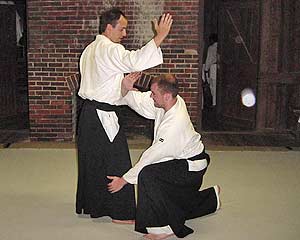
As the opponent steps forward, the defender drops down and inward (left leg forward) onto one knee under the strike. His body erect, the defender's left hand goes behind the ankle of the attacker's advancing leg, while his right forearm (bent at 90 degrees) hits into the attacker at waist level.

The defender uses his weight and forward momentum to lever (pushing with his right forearm and pulling with his left hand) the attacker backward. Notice that while his lower body is still centered, his upper torso follows into the technique.

The attacker is propelled backward onto the ground. Notice that the defender still has hold of the opponent's right leg with his left hand.
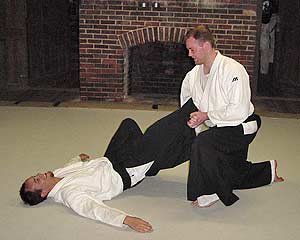
The defender's right arm then moves down, over and then under the opponent's extended leg, the right hand (palm to palm) ending on top of his left hand (thus encircling the leg and pressing up into the Achilles Tendon (several inches above the ankle) with the upper edge of the forearm).
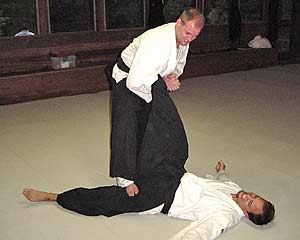
Seen from the opposite side — the defender rises and while applying upper pressure against the Achilles Tendon the right foot moves forward with his body (as he steps up) to simultaneously press down (edge of his right foot) into the inside of the attacker's left upper thigh. As this is executed the defender lifts with his back to put extra pressure on the leg – a painful submission.
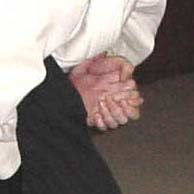
A close-up of the defender's hand position for the submission.

About the Author Christopher Caile
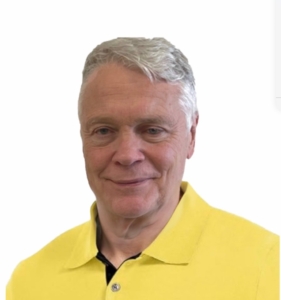
Screenshot
Christopher Caile is the Founder and Editor-In-Chief of FightingArts.com. He has been a student of the martial arts for over 65 years.
He first started in judo while in college. Then he added karate as a student of Phil Koeppel in 1959 studying Kempo and Wado-Ryu karate. He later added Shotokan Karate where he was promoted to brown belt and taught beginner classes. In 1960 while living in Finland, Caile introduced karate to that country and placed fourth in that nation's first national judo tournament.
Wanting to further his karate studies, Caile then hitch hiked from Finland to Japan traveling through Scandinavia, Europe, North Africa, the Middle East and South and Southeast Asia — living on 25 cents a day and often sleeping outside.
Arriving in Japan (1962), Caile was introduced to Mas Oyama and his fledgling full contact Kyokushinkai Karate by Donn Draeger, the famous martial artist and historian. Donn also housed him with several other senior international judo practitioners. Donn became Caile's martial arts mentor, coaching him in judo and introducing him to Shinto Muso-ryu under Takaji Shimizu.
Caile studied at Oyama's honbu dojo and also at Kenji Kurosaki's second Tokyo Kyokushinkai dojo. In his first day in class Oyama asked Caile to teach English to his chief instructor, Tadashi Nakamura. They have been friends ever since. Caile also participated in Oyama's masterwork book, "This Is Karate."
Caile left Japan with his black belt and designation as Branch Chief, the first in the US to have had extensive training in Japan directly under Oyama Sensei. As such, Oyama Sensei asked him to be his representative on visits to his US dojos to report on their status.
A little over a year later, Nakamura, Kusosaki and Akio Fujihira won an epic David vs. Goliath challenge match against Thailand's professional Muay Thai Boxers in Bangkok, Thailand, thrusting Kyolushinkai and Nakamura into national prominence.
Back in the US Caile taught Kyokushinkai karate in Peoria, Il while in college and later in Washington, DC. while in graduate school. Durimg this time Shihan Nakamura had moved to New York City to head Kyokushinkai's North American Operation.
In 1976 when Kaicho Tadashi Nakamura formed the World Seido Karate organization, Caile followed. Living then in Buffalo, NY, Caile taught Seido karate and self-defense at the State University of New York at Buffalo (SUNY Buffalo) for over 15 years where he also frequently lectured on martial arts and Zen in courses on Japanese culture.
Caile moved to New York City in 1999 to marry Jackie Veit. He is now an 8th degree black belt, Hanshi, training in Seido Karate's Westchester, NY Johshin Honzan (Spiritual Center) dojo. In Seido Caile is known for his teaching of and seminars on kata applications. He also produced a 14 segment video series on Pinan kata Bunkai currently available to Seido members.
Caile is also a long-time student and Shihan in Aikido. He studied in Buffalo, under Mike Hawley Shihan, and then under Wadokai Aikido's founder, the late Roy Suenaka (uchi deshi under Morihei Ueshiba, founder of Aikido and was Shihan under Tohei Sensei). In karate, Suenaka (8thdan) was also an in-house student of the Okinawan karate master Hohan Soken.
Having moved to New York City, Caile in 2000 founded this martial arts educational website, FightingArts.com. Twenty-five years later, in 2025, it underwent a major update and revision.
For FightingArts.com and other publications Caile wrote hundreds of articles on karate, martial arts, Japanese art, Chinese Medicine and edited a book on Zen. He also developed relationships with a cross section of leading martial arts teachers. Over the last four decades he has conducted extensive private research into karate and martial arts including private translations of the once secret Okinawan hand copied and passed on Kung Fu book, the Bubishi, as well as an early karate book by the karate master Kenwa Mabuni. He periodically returns to Japan and Okinawa to continue his studies and participate Seido karate events. In Tokyo he practiced (with Roy Suenaka Sensei) in a variety of aikido organizations with their founders – including private interviews and practices at the Aiki-kai Aikido Honbu dojo with the son and grandson of aikido's founder, Doshu (headmaster) Kisshomaru (an old uchi-deshi friend) and his son, Moriteru Ueshiba and in Iwama with Morihiro Saito. On Okinawa he studied Goju Ryu karate under Eiichi Miyazato, 10th dan founder of Naha's Jundokan, and also with Yoshitaka Taira (who later formed his own organization, who specialized in kata Bunkai. While there Caile also trained with Hohan Soken's senior student, Master Fusei Kise, 10 dan as well as with the grandson of the legendary karate master Anko Itosu.
Caile's other martial arts experience includes: Diato-ryu Aikijujitsu and Kenjitsu, kobudo, boxing, Muay Thai, MMA, Kali (empty hand, knife and bolo), study of old Okinawan Shoran-ryu & Tomari body mechanics, study of old Okinawan kata under Richard Kim, study of close quarter defense and combat, including knife and gun defenses, Kyusho Jitsu and several Chinese fighting arts including 8 Star Praying Mantis, Pak Mei (White Eyebrow), and a private family system of Kung Fu.
Caile is also a student of Zen as well as a long-term student of one branch of Traditional Chinese Medicine, Chi Kung (Qigong). As one of two senior disciples of Chi Kung master Dr. Shen (M.D., Ph.D.) Caile was certified to teach and practice. This led to Caile's founding of the The Chi Kung Healing Institute on Grand Island, NY. In Western NY, he also frequently held Chi Kung seminars, including at SUNY Buffalo and at the famous Chautauqua Institution in Chautauqua, NY. His articles on Chi Kung also appeared in the Holistic Health Journal and in several books on alternative medicine.
Caile holds a BA in International Studies from Bradley University and MA in International Relations with a specialty in South and Southeast Asia from American University in Washington, D.C. While in Buffalo, NY he also studied digital and analog electronics.
In his professional life Caile also worked in public relations and as a newspaper reporter and photographer. Earlier he worked in the field of telecommunications including Managing a Buffalo, NY sales and service branch for ITT. He then founded his own private telephone company. This was followed by creation of an electrical engineering company that designed and patented his concept for a new type of low-cost small business telephone system (which was eventually sold to Bell South). The company also did contract work for Kodak and the US space program. Simultaneously Caile designed and manufactured a unique break-apart portable pontoon boat.
Most recently Caile co-founded an internet software company. Its products include software suites with AI capability for control and management of streaming media, such as video and music, an all-in-one book publishing software product for hardcover, eBook and audio book creation and security software for buildings and government use.
For more details about Christopher Caile's martial arts, work experience and life profile, see the About section in the footer of this site.
Search for more articles by this author:






